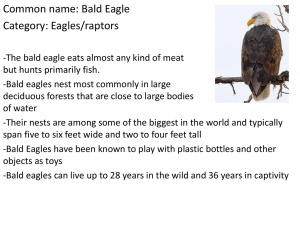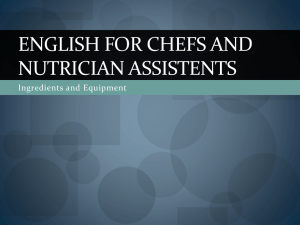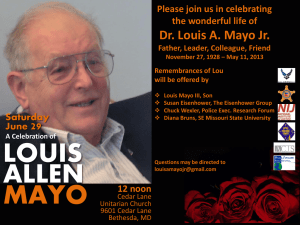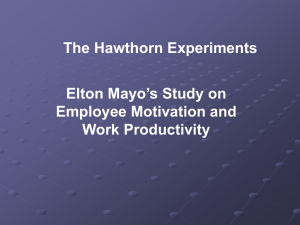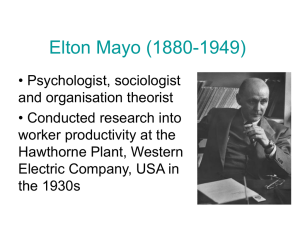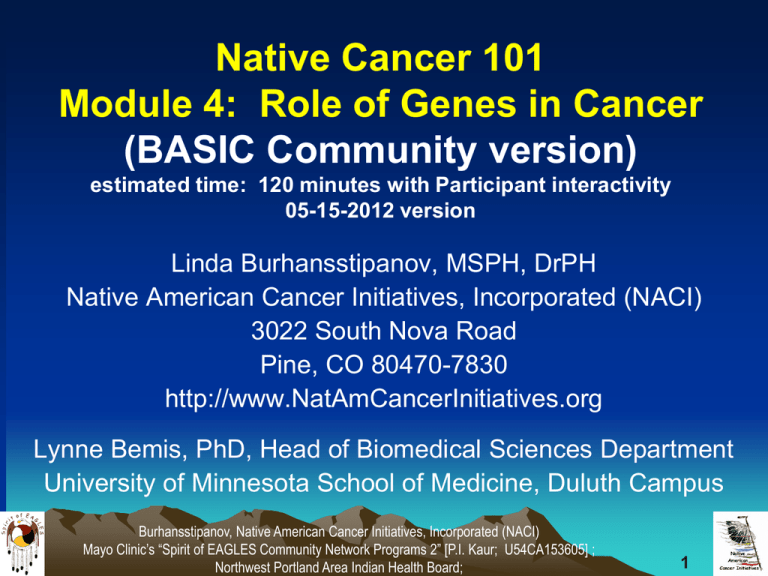
Native Cancer 101
Module 4: Role of Genes in Cancer
(BASIC Community version)
estimated time: 120 minutes with Participant interactivity
05-15-2012 version
Linda Burhansstipanov, MSPH, DrPH
Native American Cancer Initiatives, Incorporated (NACI)
3022 South Nova Road
Pine, CO 80470-7830
http://www.NatAmCancerInitiatives.org
Lynne Bemis, PhD, Head of Biomedical Sciences Department
University of Minnesota School of Medicine, Duluth Campus
Burhansstipanov, Native American Cancer Initiatives, Incorporated (NACI)
Mayo Clinic’s “Spirit of EAGLES Community Network Programs 2” [P.I. Kaur; U54CA153605] ;
Northwest Portland Area Indian Health Board;
1
Mayo SoE Native Cancer 101 Working Groups
Paulette A. Baukol, BS
Dana Kontras. RN, MSN
Linda Burhansstipanov, MSPH, DrPH
Kerri Lopez, BA
Scientific Expertise: Lynne T. Bemis, PhD, Chair of Biomedical Sciences
Department, University of Minnesota Medical School Duluth
For further information
Spirit of E.A.G.L.E.S.
Charlton 6
Mayo Comprehensive Cancer Center
200 First Street, S.W.
Rochester, MN 55905
Phone: (507) 266-3064
Fax: (507) 266-2478
baukol.paulette@mayo.edu
www.nativeamericanprograms.org
Kerri Lopez, BA
Northwest Portland Area Indian
Health Board
2121 SW Broadway, Suite 300
Portland, Oregon 97201
Phone: 503-228-4185
Fax: 503-228-8182
klopez@npaihb.org
www.npaihb.org
Burhansstipanov,
Mayo Clinic’s
Native
“Spirit
American
of EAGLES
Cancer
Community
Initiatives,Network
Incorporated
Programs
(NACI)
2” [P.I. Kaur;
Mayo Clinic’sU54CA153605]
“Spirit of EAGLES
; Northwest
Community
Portland
Network
AreaPrograms
Indian Health
2” [P.I.
Board;
Kaur;Native
U54CA153605]
American Cancer
;
Northwest Portland
Initiatives,
Area Indian
Incorporated
Health Board;
(NACI)
2
2
Please turn off your
cell phones or switch
them to “vibrate”
mode
Native Cancer 101 Module 4 (Role of
Genes) Objectives. By the end of this
session the participant will be able to:
1. Define basic genetics terminology
2. Describe the role of genes in cancer and
cancer treatment
3. Describe the benefits and limitations of
genetics testing
4. Discuss the benefit of recording your
family health history
Introduction and
overview
Genetics is not new information for AIANs
Our ancestors knew how to
Grow stronger, more
disease-resistant crops
(e.g., corn and squash)
Breed horses (Pintos,
Appaloosa) so that their
coloring blended with
rocks, ground or aspens
during the winter
©Bev Doolittle. Used by permission
of The Greenwich Workshop, Inc. for
inclusion in this slide presentation,
handout only
Burhansstipanov, Native American Cancer Initiatives, Incorporated (NACI)
Mayo Clinic’s “Spirit of EAGLES Community Network Programs 2” [P.I. Kaur; U54CA153605] ;
Northwest Portland Area Indian Health Board;
6
Genetics is not new information for AIANs
The concept of genetics is not new, but:
How genetics is being used today
New words created to describe genetic
science today
New cultural issues for protecting privacy of
individual and tribal Nations today
New science that can be generated to help
address common health problems
(diabetes, cancer) among Natives today...
Those are new ideas and concepts for AIANs
Burhansstipanov, Native American Cancer Initiatives, Incorporated (NACI)
Mayo Clinic’s “Spirit of EAGLES Community Network Programs 2” [P.I. Kaur; U54CA153605] ;
Northwest Portland Area Indian Health Board;
7
Objective 1:
Define basic genetics
terminology
genes, chromosomes,
DNA, mutation, heredity
What are “genetics”? What are “genes”?
“Genetics” is the study of “genes”
“Genes” contain the information
for the body to function
Some genes make bones
strong
Other genes help prevent
cancer (tumor suppressor)
A gene is a segment within a
chromosome
Burhansstipanov, Native American Cancer Initiatives, Incorporated (NACI)
Mayo Clinic’s “Spirit of EAGLES Community Network Programs 2” [P.I. Kaur; U54CA153605] ;
Northwest Portland Area Indian Health Board;
9
Chromosomes
Chromosomes
are packed with
thousands of
genes
Genes tell our
cells what to be
and how to act
Burhansstipanov, Native American Cancer Initiatives, Incorporated (NACI)
Mayo Clinic’s “Spirit of EAGLES Community Network Programs 2” [P.I. Kaur; U54CA153605] ;
Northwest Portland Area Indian Health Board;
10
1 = Life
2 = Species
6 = Intelligence 7 = Instinct
3 = History
4 = Fate
8 = Self- 9 = ABO Blood
11 =
10 = Cortisol
Interest
Group
and Stress Personality
5 = Environment
12 = ability to dev
human body from a
fertilized egg
18 = gene therapy
13 =BRCA2
19 =
cholesterol
14 = telomeres
20 = PRP
15 = Sex
21 = Down’s
Syndrome
16 = learning 17 = Apoptosis
22=HFW and
“Free Will”
Y = male
X = female
Chromosomes (continued)
DNA (Deoxyribonucleic Acid)
molecules refer to the genetic
information that is within the
chromosomes
Chromosomes are in the
“nucleus” (“brains” of the cell)
Chromosomes are packed
with thousands of genes
Genes tell our cells what to
be and how to act
Burhansstipanov, Native American Cancer Initiatives, Incorporated (NACI)
Mayo Clinic’s “Spirit of EAGLES Community Network Programs 2” [P.I. Kaur; U54CA153605] ;
Northwest Portland Area Indian Health Board;
12
More about “Genes” and “Mutations”
The pattern of information within genes needs
to follow a specific sequence for the cell to
function correctly.
When the sequence differs, it is called a
“mutation” (or SNP, pronounced “snip”)
Everybody has mutations (or SNPs) that may
cause:
No effect on the function of the gene
The gene to continue having the normal
function
Burhansstipanov, Native American Cancer Initiatives, Incorporated (NACI)
Mayo Clinic’s “Spirit of EAGLES Community Network Programs 2” [P.I. Kaur; U54CA153605] ;
Northwest Portland Area Indian Health Board;
13
Example: p53 (“The Big Guy”)
The gene to do something different than
what it was supposed to do
Human chromosomes have a segment of
a gene called “p53”
Dr. Bemis calls “p53”, “The Big Guy”
More than half of all tumors have
damage in the area of the gene that
makes up “p53”
p53 helps protect the body against cancer
p53 is a tumor suppressor
Unless it is damaged (mutation)
Burhansstipanov, Native American Cancer Initiatives, Incorporated (NACI)
Mayo Clinic’s “Spirit of EAGLES Community Network Programs 2” [P.I. Kaur; U54CA153605] ;
Northwest Portland Area Indian Health Board;
14
More about “Genes” (continued)
The nucleus has genetic information
provided from your mother and from your
father.
The human body has about 20,000 genes.
Every human being is 99.9% similar to any
other human being
That 0.1% of genetic information is why
and how we look and are different from
one another
Burhansstipanov, Native American Cancer Initiatives, Incorporated (NACI)
Mayo Clinic’s “Spirit of EAGLES Community Network Programs 2” [P.I. Kaur; U54CA153605] ;
Northwest Portland Area Indian Health Board;
15
QUESTION: What does “heredity” mean?
Heredity” means that the
characteristic came from the
sperm and egg (from your dad
and mom) when you were
conceived in the womb
23 chromosomes from dad
(sperm) and 23 from mom
(egg); a copy of each
chromosome to fertilized egg
Burhansstipanov, Native American Cancer Initiatives, Incorporated (NACI)
Mayo Clinic’s “Spirit of EAGLES Community Network Programs 2” [P.I. Kaur; U54CA153605] ;
Northwest Portland Area Indian Health Board;
16
Causes of Cancer
Daily Behavior / Lifestyle (not enough physical
activity, unhealthy food, excess alcohol, habitual
use of tobacco) = cause changes in genes within
body cells
Environment (exposure to contaminants, e.g.,
asbestos) = cause changes in genes within body
cells
Heredity (chromosomes from mother and father
that created the fertilized egg that resulted in the
child)
= only 5-10% of all cancers
Burhansstipanov, Native American Cancer Initiatives, Incorporated (NACI)
Mayo Clinic’s “Spirit of EAGLES Community Network Programs 2” [P.I. Kaur; U54CA153605] ;
Northwest Portland Area Indian Health Board;
17
Objective 2: Describe
role of genes in cancer
Role of genes in cancer
Only a small group of mutations directly
associated with cancer risk are inherited
from the parents
Other (i.e., “most”) mutations are acquired
over the life span
Multiple injuries occur to the same cell to
evolve or result in cancer
“Injuries” can be from alcohol abuse,
exposure to commercial tobacco,
bacteria, virus, inactivity, unhealthy diet
Burhansstipanov, Native American Cancer Initiatives, Incorporated (NACI)
Mayo Clinic’s “Spirit of EAGLES Community Network Programs 2” [P.I. Kaur; U54CA153605] ;
Northwest Portland Area Indian Health Board;
19
Role of genes: mutations
The injury is a mutation resulting in
damage that is passed on from the first
body (somatic) cell as it divides into
additional cells
It gives the cells harboring the mutation
an advantage to outgrow other cells
For example in lung cancer the
carcinogens in cigarette smoke may
cause damage in several genes
Burhansstipanov, Native American Cancer Initiatives, Incorporated (NACI)
Mayo Clinic’s “Spirit of EAGLES Community Network Programs 2” [P.I. Kaur; U54CA153605] ;
Northwest Portland Area Indian Health Board;
20
Role of genes: mutations (continued)
One change may allow the cells to
grow out of control while another may
cause the cells to be resistant to
therapy
Multiple injuries are required before
the cells are changed enough to allow
them to grow out of control
For most solid tumors, 5-10 separate
“injuries” occur before the cell
becomes cancer
Burhansstipanov, Native American Cancer Initiatives, Incorporated (NACI)
Mayo Clinic’s “Spirit of EAGLES Community Network Programs 2” [P.I. Kaur; U54CA153605] ;
Northwest Portland Area Indian Health Board;
21
Interactivity: Chromosome Ropes
Rope chromosomes
(100,000 of times larger
than actual chromosomes)
Telomere
Centromere
“Single Nucleotide
Polymorphism” (SNP) /
mutation
p seqment
q segment
Longest chromosome =1;
Shortest chromosome = 22
Germ (sex) cells (2)
Interactivity: Chromosome Ropes
Please work in pairs
Each envelop has an enlarged, but proportional
rope
Please look at the chromosome
What is the number of your chromosome?
Where is the “centromere”?
Do you have a “Single Nucleotide Polymorphism”
(SNP)?
Where is the SNP located? p? or q?
What disease is related to your SNP?
Make a copy of the chromosome you are
using from the 2nd envelope (clipped)
In your pairs, please make 2 chromosomes
that match the ones provided from the 1st
envelope
You will have a total of 4 rope
chromosomes; please return the original 2
in the envelope
Each of you should have a pair of rope
chromosomes
One of you is from the male (sperm) and
the other is from the female (egg)
Role of genes in cancer (continued)
A variety of genes are known to be
‘injured’ in cancer.
Two overall types of injuries occur
Those that block the expression of “Tumor
suppressor” genes like
p53, BRCA1 and BRCA2
Those that activate oncogenes (genetic
markers / SNPs that contribute to cancer)
KRAS, BRAF, EGFR
Burhansstipanov, Native American Cancer Initiatives, Incorporated (NACI)
Mayo Clinic’s “Spirit of EAGLES Community Network Programs 2” [P.I. Kaur; U54CA153605] ;
Northwest Portland Area Indian Health Board;
25
Chromosomal changes in Cancer
There are frequent mutations in cancer cells
Sometimes there are large rearrangements
Sometimes there are deletions of part of a
chromosome
Sometimes there are small changes that may
only be detected with PCR or other genetic
tests.
NOTE: PCR stands for polymerase chain reaction. This is the method that allows
researchers to copy and amplify almost any piece of DNA to better understand it. Many
of the genetic tests currently in use require PCR as part of the process of determining if
the patient has a SNP
Burhansstipanov, Native American Cancer Initiatives, Incorporated (NACI)
Mayo Clinic’s “Spirit of EAGLES Community Network Programs 2” [P.I. Kaur; U54CA153605] ;
Northwest Portland Area Indian Health Board;
26
Chromosomal Changes in Cancer
Sometimes a test can be developed that
looks at large regions of DNA changes
Other times a few regions of a gene are
examined
BRCA1 and BRCA2 are very large genes
known to harbor many mutations that may
be passed from the parent to child
Burhansstipanov, Native American Cancer Initiatives, Incorporated (NACI)
Mayo Clinic’s “Spirit of EAGLES Community Network Programs 2” [P.I. Kaur; U54CA153605] ;
Northwest Portland Area Indian Health Board;
27
QUESTION: What is a BRCA2 mutation?
BRCA2 is a protein that helps to repair
certain kinds of damage to DNA
BRCA2 is a very large gene composed of
84,188 base pairs
Hundreds of mutations have been
discovered in BRCA2 and some are
associated with certain ethnic groups
SEE YELLOW LAMINATED SHEETS WITH
BRCA2 SUMMARY INFO (or use the following yellow slides end of module)
Burhansstipanov, Native American Cancer Initiatives, Incorporated (NACI)
Mayo Clinic’s “Spirit of EAGLES Community Network Programs 2” [P.I. Kaur; U54CA153605] ;
Northwest Portland Area Indian Health Board;
28
Scenario: Mary Lou (your sister) was just
diagnosed with breast cancer
Please form groups of 4 and review the yellow
laminated BRCA2 summary)
BRCA2 is a genetic form called “BRCA2” (BR
from “breast” and CA for “cancer” and “2”
because it was the 2nd hereditary breast cancer
gene
Catherine, your other sister doesn’t know if she
is carrying the same type of genetic marker
(BRCA2)
What additional information do you want before
you decide whether to have the BRCA2 test?
29
Objective 3: Describe
potential benefits and
drawbacks of genetics
testing
Mary Lou Scenario continued
The BRCA2 test is expensive ($1200).
Who will pay for the test? What are
your options? Will IHS pay for BRCA2
testing?
Who do you think SHOULD pay for the
test?
Do you know of any clinical trials in
your area that may pay for the BRCA2
test?
How would you find such a clinical trial?
Burhansstipanov, Native American Cancer Initiatives, Incorporated (NACI)
Mayo Clinic’s “Spirit of EAGLES Community Network Programs 2” [P.I. Kaur; U54CA153605] ;
Northwest Portland Area Indian Health Board;
31
Scenario continued
Catherine (Mary Lou’s sister) decided to
have the test and her results were
negative.
How does that impact or affect your
potential test results?
Craig is your older brother. He is having
problems with an enlarged prostate.
Mary Lou told him that BRCA2 is
related to prostate cancer in men. Now
Craig is fretting.
Burhansstipanov, Native American Cancer Initiatives, Incorporated (NACI)
Mayo Clinic’s “Spirit of EAGLES Community Network Programs 2” [P.I. Kaur; U54CA153605] ;
Northwest Portland Area Indian Health Board;
32
Using BRCA2 As An Example
Having the marker (BRCA2) does not
mean you will develop cancer
The marker indicates a predisposition
Every single person has a BRCA2 gene,
but only a few have a mutation
Populations at risk are on following page
Using BRCA2 As An Example
Populations
BRCA2
who may carry
mutation(s)
the mutation
Ashkenazi
Jewish
6174delT
Dutch
5579insA
French
Canadians
8765delAG
Result of the mutation
A deletion of a T base results
in a shorter than normal
protein
An extra base (A) causes
altered expression of the
protein
In this case two base pairs
are missing
Possible Personal Benefits of Genetic Testing
QUESTION: What are examples of some
ways that an individual may personally
benefit from participating in genetic tests?
Medical and lifestyle choices are
available for selected conditions
Learns whether s/he does or does not
have an altered gene
Learns to cope with the personal risk
Burhansstipanov, Native American Cancer Initiatives, Incorporated (NACI)
Mayo Clinic’s “Spirit of EAGLES Community Network Programs 2” [P.I. Kaur; U54CA153605] ;
Northwest Portland Area Indian Health Board;
35
Possible Personal Benefits of Genetic Testing
Decide whether or not to have surgery
(possibly protective surgery)
Provide useful information to other family or
tribal members
Contribute to research
If people know that “genetic” risk is not the
cause of disorder, more likely to address
behavioral / lifestyle “risks”
Change behavior (e.g. take part in screening)
Burhansstipanov, Native American Cancer Initiatives, Incorporated (NACI)
Mayo Clinic’s “Spirit of EAGLES Community Network Programs 2” [P.I. Kaur; U54CA153605] ;
Northwest Portland Area Indian Health Board;
36
Possible Personal Benefits of Genetic Testing
More effective and efficient treatments
tailored to the individual
An example is the relatively new field of
science called, “pharmacogenetics”
The study of medications and genetics
Burhansstipanov, Native American Cancer Initiatives, Incorporated (NACI)
Mayo Clinic’s “Spirit of EAGLES Community Network Programs 2” [P.I. Kaur; U54CA153605] ;
Northwest Portland Area Indian Health Board;
37
How Might the Tribe or Other Native
Americans Benefit by an Individual
Participating in Genetic Testing?
Information about common conditions may
be helpful to others
Communities can focus on behavior
changes rather than assume “fatalistic”
attitude about a disease
Burhansstipanov, Native American Cancer Initiatives, Incorporated (NACI)
Mayo Clinic’s “Spirit of EAGLES Community Network Programs 2” [P.I. Kaur; U54CA153605] ;
Northwest Portland Area Indian Health Board;
38
Possible Drawbacks to Genetic Testing
A genetic “mutation” that NEVER results in
a disease (i.e., worry about “nothing”)
What does “lifetime risk” mean? How
does “lifetime risk” relate to tribal beliefs or
cultural mores?
Genetic “mutation” may be present, but
there may not be “treatment”
Burhansstipanov, Native American Cancer Initiatives, Incorporated (NACI)
Mayo Clinic’s “Spirit of EAGLES Community Network Programs 2” [P.I. Kaur; U54CA153605] ;
Northwest Portland Area Indian Health Board;
39
Possible Drawbacks to Genetic Testing
The test may be limited to only one part of
a gene, and not the part of the gene that
has the mutation (the test is “limited”)
The test may be inaccurate
“false positives” or “false negatives”
Negative test results may provide a
false sense of security
An individual may find it harder to cope
with the cancer risk when s/he knows the
test results
Burhansstipanov, Native American Cancer Initiatives, Incorporated (NACI)
Mayo Clinic’s “Spirit of EAGLES Community Network Programs 2” [P.I. Kaur; U54CA153605] ;
Northwest Portland Area Indian Health Board;
40
Possible Drawbacks to Genetic Testing
You may be asked to disclose genetic test
findings that may result in the participant:
Losing health insurance coverage
Other family members losing their health
insurance
Losing his/her job
NOTE: Federal and state laws are supposed
to protect against such outcomes, but they
are imperfect
Burhansstipanov, Native American Cancer Initiatives, Incorporated (NACI)
Mayo Clinic’s “Spirit of EAGLES Community Network Programs 2” [P.I. Kaur; U54CA153605] ;
Northwest Portland Area Indian Health Board;
41
Genetic Information Nondiscrimination Act of
2008 (GINA), a Federal law
Prohibits discrimination in health coverage and
employment based on genetic information
generally prohibits health insurers or health plan
administrators from requesting or requiring
genetic information of an individual or the
individual’s family members, or using it for
decisions regarding coverage, rates, or
preexisting conditions.
The law also prohibits most employers from
using genetic information for hiring, firing, or
promotion decisions, and for any decisions
regarding terms of employment
Burhansstipanov, Native American Cancer Initiatives, Incorporated (NACI)
Mayo Clinic’s “Spirit of EAGLES Community Network Programs 2” [P.I. Kaur; U54CA153605] ;
Northwest Portland Area Indian Health Board;
42
How Might My Tribe or Other Native
Americans by Harmed by My Participating
in Genetic Testing?
Tribal ordinances against participating in
“genetic research” (genetic testing may be
included in genetic research)
“Genetic testing” is an individual decision,
there should be little opportunity for harm
to the Tribal community
Burhansstipanov, Native American Cancer Initiatives, Incorporated (NACI)
Mayo Clinic’s “Spirit of EAGLES Community Network Programs 2” [P.I. Kaur; U54CA153605] ;
Northwest Portland Area Indian Health Board;
43
Native American Cultural and Ethical Issues
related to Genetic Testing
NOTE: Due to projects such as HGDP
targeting Aboriginal Peoples, communities
are suspicious of any program involving
“genetics”
Native people being encouraged to take
part in genetic testing by being given
rewards ... without being told the risks of
genetic tests.
Burhansstipanov, Native American Cancer Initiatives, Incorporated (NACI)
Mayo Clinic’s “Spirit of EAGLES Community Network Programs 2” [P.I. Kaur; U54CA153605] ;
Northwest Portland Area Indian Health Board;
44
Native American Cultural and Ethical Issues
related to Genetic Testing
Native people being tested without being
given enough information to make an
“informed” decision
Native people being tested without having
their rights to privacy and confidentiality
“protected”
Native people being tested without having
test results clearly explained (no genetic
counseling)
Burhansstipanov, Native American Cancer Initiatives, Incorporated (NACI)
Mayo Clinic’s “Spirit of EAGLES Community Network Programs 2” [P.I. Kaur; U54CA153605] ;
Northwest Portland Area Indian Health Board;
45
Objective 4: Discuss the
benefit of recording
your family health
history
slides from NACI GENA® objective 22
(used with permission from Linda B)
Reasons Family Histories May be
Important
Accurate Family Histories are needed to
determine if a cancer risk is likely to be
hereditary or from other causes (daily
behaviors, exposure to environmental
contamination)
Helps the genetic counselor work with the
patient to decide whether or not the patient
is genetically at high risk for a condition
and should have a genetic test (most
cancer genetic tests are expensive)
Burhansstipanov, Native American Cancer Initiatives, Incorporated (NACI)
Mayo Clinic’s “Spirit of EAGLES Community Network Programs 2” [P.I. Kaur; U54CA153605] ;
Northwest Portland Area Indian Health Board;
47
Reasons Family Histories May be
Important (cont.)
Helps the provider make a diagnosis
Clarifies daily behaviors versus inherited
risks for people who are adopted
May reveal patterns of inheritance within
the family
Clarifies family myths regarding who in
the family is at risk
Helps explain why some members of the
family are not affected
Burhansstipanov, Native American Cancer Initiatives, Incorporated (NACI)
Mayo Clinic’s “Spirit of EAGLES Community Network Programs 2” [P.I. Kaur; U54CA153605] ;
Northwest Portland Area Indian Health Board;
48
Sample Cancer Family History Questionnaire
1.
2.
3.
4.
5.
Name
Date
Age
Ethnic Background
Do you have any specific concerns about
cancer in yourself or your family?
6. Do you or any members of your family
have a history of cancer?
Burhansstipanov, Native American Cancer Initiatives, Incorporated (NACI)
Mayo Clinic’s “Spirit of EAGLES Community Network Programs 2” [P.I. Kaur; U54CA153605] ;
Northwest Portland Area Indian Health Board;
49
Yes /
No
Type of
Cancer
(if known)
yourself
your mother
your father
your sisters & brothers
your children
your mother's sisters &
brothers
your father's sisters
and brothers
your nieces & nephews
your mother's parents
your father's parents
Age at
Dx
Living /
Deceased
Example of Culturally Inappropriate Family
History Data Collection by Epidemiologists
during the Hanta Virus Infection
CDC scientists demanded to interview the
surviving family members immediately
following the patient’s death
Researchers unaware / unwilling to be
educated by local Native physician of local
cultural beliefs requiring no discussion of
the deceased for 3 days
Burhansstipanov, Native American Cancer Initiatives, Incorporated (NACI)
Mayo Clinic’s “Spirit of EAGLES Community Network Programs 2” [P.I. Kaur; U54CA153605] ;
Northwest Portland Area Indian Health Board;
51
Example of Culturally Inappropriate Family
History Data Collection by Epidemiologists
during the Hanta Virus Infection
Family forced to violate cultural practices =
very difficult ceremony
Researchers given inaccurate information
Alienated the local AI community
Video Role Play of poor family history
collection
Video role Play of good family history
collection
Burhansstipanov, Native American Cancer Initiatives, Incorporated (NACI)
Mayo Clinic’s “Spirit of EAGLES Community Network Programs 2” [P.I. Kaur; U54CA153605] ;
Northwest Portland Area Indian Health Board;
52
Family History Data Collection Cautions
Asking the patient and/or family members
personal information about their ancestors
and immediate family
Some tribes are prohibited from discussing
family members who have “walked on” /
“passed away” / died
Cannot use their name
Cannot refer to them directly via
relationship (“mother”, “father”)
Burhansstipanov, Native American Cancer Initiatives, Incorporated (NACI)
Mayo Clinic’s “Spirit of EAGLES Community Network Programs 2” [P.I. Kaur; U54CA153605] ;
Northwest Portland Area Indian Health Board;
53
Family History Data Collection Cautions
Violations of these cultural practices can
result in the family having to do timely and
expensive ceremonies
Linear format of family / Family History
collection process frequently results in
erroneous information
Encourage patient to “tell a story”
Be careful about how we talk about our
relatives (“my daughter”)
Burhansstipanov, Native American Cancer Initiatives, Incorporated (NACI)
Mayo Clinic’s “Spirit of EAGLES Community Network Programs 2” [P.I. Kaur; U54CA153605] ;
Northwest Portland Area Indian Health Board;
54
“First Degree Relative” vs. Indian Adoption
Note: some tribes use maternity for tribal
affiliation rather than paternity
Cancer risk genetic tests typically focus on first
degree relatives (FDRs)
Mother, Father
Sisters, Brothers
Children
Spiritually, adopted children are regarded as
FDR by AIANS, but NOT so for genetic family
trees …
question: “did you come from the same
womb as your brother?”
Burhansstipanov, Native American Cancer Initiatives, Incorporated (NACI)
Mayo Clinic’s “Spirit of EAGLES Community Network Programs 2” [P.I. Kaur; U54CA153605] ;
Northwest Portland Area Indian Health Board;
55
“First Degree Relative” vs. Indian Adoption
Indian cultures actively support adoption of
others who need or want assistance /
guidance
Cousins, aunties, uncles, other relatives
Other members / children / youth of the
community
Friends / their children / youth
Challenging to distinguish among “blood” relatives
and “adopted” relatives via AIAN beliefs
Burhansstipanov, Native American Cancer Initiatives, Incorporated (NACI)
Mayo Clinic’s “Spirit of EAGLES Community Network Programs 2” [P.I. Kaur; U54CA153605] ;
Northwest Portland Area Indian Health Board;
56
Summary / Take Home
Messages
Summary; Take Home Messages
The most common risks for developing
cancer are daily behaviors (diet, exercise,
tobacco exposure, alcohol excess)
Our ancestors understood genetics very
well (that is why we have marriage rules)
New scientific words are used to describe
much more detailed (molecular / genetic)
levels of genetics
“Chromosomes”, “genes” and “markers”
are common words in the News today
Burhansstipanov, Native American Cancer Initiatives, Incorporated (NACI)
Mayo Clinic’s “Spirit of EAGLES Community Network Programs 2” [P.I. Kaur; U54CA153605] ;
Northwest Portland Area Indian Health Board;
58
Summary: Take Home Messages
Healthy body (somatic) cells are damaged
by daily behaviors or sometimes by
exposure to environmental contaminants
The same cells are injured 5-10 times
before the cells begin to become cancer
Researchers are using the new, detailed
genetic and molecular information to tailor
cancer treatments
Some of these treatments are available
already (e.g., colon, melanoma)
Burhansstipanov, Native American Cancer Initiatives, Incorporated (NACI)
Mayo Clinic’s “Spirit of EAGLES Community Network Programs 2” [P.I. Kaur; U54CA153605] ;
Northwest Portland Area Indian Health Board;
59
Summary: Take Home Messages
Information collected during your family
history can help the researchers
understand your genetic or molecular
information better
Collecting family histories in Indian
Country is challenging, in part because:
Some tribal cultures prohibit the use of
family relations who have passed on
(e.g., you cannot say, “father” or
“sister”)
Burhansstipanov, Native American Cancer Initiatives, Incorporated (NACI)
Mayo Clinic’s “Spirit of EAGLES Community Network Programs 2” [P.I. Kaur; U54CA153605] ;
Northwest Portland Area Indian Health Board;
60
Summary: Take Home Messages
Most of our tribal Nations practice
casual adoption of nieces, neighbors
and others who need a home
Once adopted, they are of our family
spiritually …
we do not distinguish siblings as
coming from the same womb, but
spiritually we are sisters
Burhansstipanov, Native American Cancer Initiatives, Incorporated (NACI)
Mayo Clinic’s “Spirit of EAGLES Community Network Programs 2” [P.I. Kaur; U54CA153605] ;
Northwest Portland Area Indian Health Board;
61
Thank you for
allowing us to share
the current draft of
this Native module
with you
Burhansstipanov, Native American Cancer Initiatives, Incorporated (NACI)
Mayo Clinic’s “Spirit of EAGLES Community Network Programs 2” [P.I. Kaur; U54CA153605] ;
Northwest Portland Area Indian Health Board;
62
Example of Chromosome 1 =
Life; gene for lactase that is necessary to digest lactose, a
sugar abundant in milk; most humans are born with this gene
switched on in their digestive systems. The gene turns off and
adults may have difficulty digesting lactose. One way around
the problem is to let bacteria digest the lactose and turn the
milk into cheese. Cheese, being low in lactose, is easily
digestible for adults and children.
A mutation in the control gene that switches off the lactase
gene results in people who can drink and digest milk all
through life.
More than 70% of western Europeans by descent can drink
milk as adults, compared with less than 30% of people from
parts of Africa, eastern and southeastern Asia and Oceania
(Ridley, p. 193)
Some facts about your life depend entirely
on a single gene--for example, whether
you'll get the dreadful degenerative disease
Huntington's chorea, and if so, at what age
Huntington disease (HD) is a
neurodegenerative disorder caused by the
addition of nucleotides within the HD gene.
Huntingtin is the name for the very large
protein that is disfunctional in HD.
Example of chromosome 10 =
CYP17 enables the body to convert cholesterol into cortisol,
testosterone and oestradiol.
Cortisol interferes with the immune system, changes sensitivity of the
ears, nose and eyes, and alters various bodily functions.
When you have a lot of cortisol, you are “under stress”. Cortisol and
Stress are synonymous (Ridley, p. 149).
Because cortisol interferes with the immune system when under stress,
a person is more likely to “catch a cold” or other infections. Cortisol
does this by reducing the activity, number and lifetime of lymphocytes
(white blood cells)
Example of Chromosome 11 =
Personality; The D4DR gene is one of the brain’s
dopamine-mediated pathways. Dopamine
pathways control the flow of blood through the
brain. A shortage of dopamine in the brain
causes an indecisive and frozen personality,
unable to initiate even the body’s own
movement… in the extreme = Parkinson Disease.
An excess of dopamine = highly exploratory and
adventurous or related to Schizophrenia.
Too little dopamine and the person lacks initiative
and motivation;
Too much and the person is easily bored &
frequently seeks new adventures. (Ridley , p. 163)
Example of Chromosome 14 =
Immortality; TEP1 telomerase (top of the chromosomes) contains
RNA which rebuilds telomeres (Ridley, p. 197)
Note: Dolly the sheep’s descendents grow up “older” than other
sheep because they have shorter telomeres so even though they
were baby sheep they had older seeming chromosomes.
Examples of Chromosome 15 genes =
Sex-related anomalies from missing chunks of chromosome from
one of the parents
Prader-Willi Syndrome: children born floppy and pale-skinned;
refuse to suck at the breast, but later eat till they almost burst …
never experiencing satiety;
Or the opposite, Angelman’s syndrome: children born taut; thin,
hyperactive, insomniac, small-headed, long-jawed, move jerkily;
often stick out large tongues; BUT have happy dispositions, smiling
and frequent outbursts of laughter (Ridley, p. 207). They never learn
to speak; severely mentally retarded
Example(s) of Chromosome 17 genes =
ced-9 or gene that helps old cells die (Apoptosis)
Oncogenes and cancer Tumor suppressor genes turned off = cancer
Gene that tells cells to commit suicide is TP 53 which makes p53.
A mutation in TP53 is related to cancer (55% of all human cancers have
damage to TP53 and 90% of all lung cancers have damage to TP53).
(Ridley, p. 236)
People born with one faulty version of TP53 out of the two they inherit
have a 95% change of getting cancer and usually at an early age.
Lynne calls p53, “the big guy” for this reason
Colorectal cancer and APC and/or ras related to polyps
Example of Chromosome 20 =
PRP (protease-resistant protein) and prions that reshape
normal prions and how they “fold up”… 1986 and bovine
spongiform encephalopathy … “mad cow disease”
NACI’s Edited Background Information
BRCA2 Summary Fact Sheet
Discovered: 1995
Location 13q12
Very large gene
Tumor suppressor
Genetics:
Autosomal dominant transmission of
germline alteration (mutation)
Transmission of germline mutation by
EITHER parent
71
NACI’s Edited Background Information
BRCA2 Summary Fact Sheet (cont.)
Germline mutation increases RISK for
breast and ovarian cancers
Cancer is a progressive process of
different mutations that alter cell function.
Eventually, cell function is altered so much
that it becomes “cancerous”.
72
NACI’s Edited Background Information
BRCA2 Summary Fact Sheet (cont.)
An inherited susceptibility to cancer, like a
germline mutation in BRCA2 gene, means
that a person has inherited a “damage”
which decreases the number of further
acquired mutations needed for a cell to
become cancerous.
i.e., most “cancer” evolves after at least
“two” damages
73
NACI’s Edited: Increased Cancer Risks for
Mutations in BRCA2:
Women
Breast cancer
Ovarian cancer (not as high as BRCA1
mutations)
Men
Breast cancer
Prostate cancer
74
NACI’s Edited Increased Cancer Risks
for Mutations in BRCA2:
Other Cancers (risk for these may be
slightly elevated over the general
population)
Colon cancer
Pancreatic cancer
Stomach cancer
Cancer of the gallbladder
Melanoma
75


